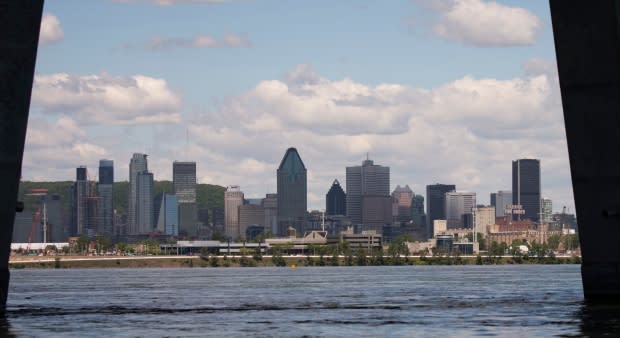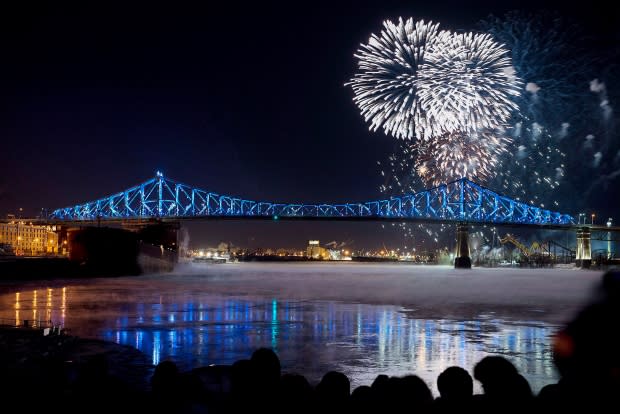Samuel De Champlain Bridge set to open, replacing Canada's busiest bridge
Motorists heading to Montreal from the city's South Shore today will be able to drive over the new Samuel De Champlain Bridge for the first time.
After four years of construction and months of delays, the $4-billion, 3.4-kilometre bridge over the St. Lawrence River will open at 5 a.m. in the northbound direction on Quebec's Fête nationale, a provincial holiday.
Southbound lanes won't open until a week later, on Canada Day.
The new structure, simple and sleek in design, replaces the former Champlain Bridge, a steel truss cantilever bridge alongside it that has been a fixture on the skyline since it opened in 1962.
In recent years, it had fallen into disrepair, costing taxpayers millions annually to maintain. The new bridge is expected to last 125 years.
The old bridge is considered the busiest in Canada, crossed by more than 50 million vehicles and some $20-billion in international trade goods every year.
The new, federally funded bridge is touted by Ottawa as one of the largest public infrastructure projects in North America.
In a statement earlier this month, Federal Infrastructure Minister François-Philippe Champagne congratulated "the heroes of this project" who worked "tirelessly and with dedication to build the Samuel De Champlain Bridge."

The bridge, Champagne added, "is sure to be a source of pride."
There's still work to do, however, including the addition of a light-rail train network and path for pedestrians and cyclists.
Light-rail network to serve millions
The bridge will be a crucial South Shore link for the city's new light-rail system (REM). By 2021, some 11 million public transit users are expected to cross the bridge every year.
The REM will run across a central deck between the two traffic lanes, replacing the reserved bus lanes. With the deck already in place, adding the tracks will not disrupt traffic, an REM spokesperson confirmed Friday.
The REM will have stops on either side of the bridge in Brossard and on Nun's Island.
Montreal will have 212 train cars in its REM network, departing in four-car segments during rush hour and two cars at off-peak hours to save energy.
Each automated train, with a maximum capacity of 780 passengers, will eventually offer connections to 26 stations spread out across the region, connected by 67 kilometres of track.
Pedestrian and cyclist path
The consortium behind the bridge project, Signature on the Saint Lawrence (SSL), is contractually obligated to open the new pedestrian and bicycle path within 120 days of the bridge's opening.
An SSL spokesperson said the plan is to open it around the end of September. The path will be on the northeast side of the bridge, with four lookouts offering views of the city's skyline.

A direct cyclist and pedestrian route between Montreal and Brossard was not available on the old Champlain Bridge. Now users will be able to access the bicycle path network in Montreal and on Nun's Island.
It will also be part of La Route Verte, which, at 5,300 kilometres, is the longest network of cycling trails in North America.
Lots and lots of lights
The new bridge will be strung with 7,500 individually controlled light-emitting diodes, commonly called LEDs. The lights are designed to highlight the bridge's architecture.
By comparison, the Jacques Cartier Bridge, which is almost the exact same length as the new bridge, has 2,807 LEDs.

Each luminaire can display "an almost infinite palette of colours," SSL says. The lighting control will be centralized and will display programmable themes of adjustable colours and intensity.
The basic theme will be a blank display, but themes associated with major events will be possible, SSL says.
Crews will be finishing the Champlain bridge's lighting and landscaping throughout the summer.
By the numbers
The bridge is about as long as the longest runway at Montreal's Pierre Elliott Trudeau Airport and about as tall as the Olympic Stadium — the Big O is just five metres taller.
The cable-stayed section of the bridge measures 500 metres, or more than three and a half Canadian football fields.
There are two elevators inside the main pylon, which can now be seen from several kilometres away with thick cables spanning out in either direction.
To construct the bridge, 42 concrete piles measuring 1.2 metres in diameter were driven 20 metres into the bedrock.
There are more than one million bolts holding the bridge together, 74 pillars and 74 foundations. Each foundation weighs 604 tonnes, or the equivalent of four blue whales.
In total, 2,000 workers dedicated more than 8.5 million hours to its construction.
Months of delays
The bridge was originally slated to open in December 2018. SSL, led by SNC-Lavalin, won the $4.2-billion contract knowing late fees would amount to $100,000 per day for the first seven days and $400,000 per day after that.

The maximum penalty was capped at $150 million.
SSL went over the original estimated cost by $235 million, meaning the actual price tag could come in at around $4.5 billion. The federal government is still in discussions with SSL about who is to blame for the delays and cost overruns.


